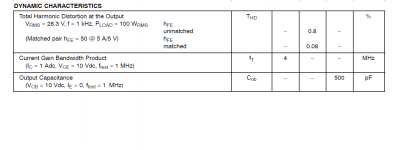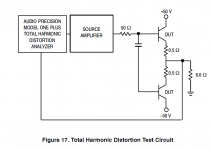tiefbassuebertr,
What I`m saying is that for low distortion the operating frequency range must be wide, ideally infinite.
So?This is right.
But on the other hand Mr. Nelson Pass don't use such 40MHz-80MHz BjT devices neither in the Threshold aera nor in the passlabs aera. He use only Motorola BjT parts in the Threshold area and in the passlabs aera only power MOSFETs (instead expensive high Ft BjT's) from IRF. Also by the currently models, where are inside PP instead single ended output stages.
And as I know, nevertheless there are nothing other Class-A solid state amp model with 80 MHz BjT devices inside, that clearly do outperform the models from "X" and "XA" series, even not the legendary 400A and 800A with slow Motorola BjT's.
What I`m saying is that for low distortion the operating frequency range must be wide, ideally infinite.
BV,
The subject has been investigated thoroughly for everyone who wants to know. PMA has unlikely the means to carry out a trustworthy scientific research.PMA had made on our local forum test, he posted recording with various levels of low order added distortion (without information what he made) . Even "golden ears" cannot hear and tell what is diference between tracks, and distortion levels was about 1% and more .
Sound quality has no quantifiable and expressible quantities. Nevertheless, people will continue to turn subjective values into figures and graphs to infinity, fooling themselves and others.Lumba, if You preferred "rich, warm, musical..." sound (with high level of low order distortion and IMD product) , it is OK, it is Your taste.. But then please talk not about technical facts as linearity and technology of "switching" devices, and especially not about "linearity according to the ear`s own scale" .
You are right in one point, measurements say nothing, but only about personal preferences. They can tell quite all about objective performance , off course not single 1kHz THD+N measurement.
"Sound quality has no quantifiable and expressible quantities. Nevertheless, people will continue to turn subjective values into figures and graphs to infinity, fooling themselves and others. "
Nonsense.
The number help us make sense of the realities. And, If the numbers cannot expLain everything we experience, then we have to investigate some more until we find the cause. However, I doubt we are missing some fundamental insights in Audio . . . it is a mature and well understood branch of engineering. Period.
Nonsense.
The number help us make sense of the realities. And, If the numbers cannot expLain everything we experience, then we have to investigate some more until we find the cause. However, I doubt we are missing some fundamental insights in Audio . . . it is a mature and well understood branch of engineering. Period.
Sound quality no, but quality of equipment intended for reproduction of sound yes. Music is subjective, not reproduction. It is strictly technical .Sound quality has no quantifiable and expressible quantities. Nevertheless, people will continue to turn subjective values into figures and graphs to infinity, fooling themselves and others.
Last edited:
"Quote from Lumba Ogir - Sound quality has no quantifiable and expressible quantities. Nevertheless, people will continue to turn subjective values into figures and graphs to infinity, fooling themselves and others. "
Bonsai: Nonsense.
The number help us make sense of the realities. And, If the numbers cannot expLain everything we experience, then we have to investigate some more until we find the cause. However, I doubt we are missing some fundamental insights in Audio . . . it is a mature and well understood branch of engineering. Period.
... well understood branch of engineering ??? Hard to believe for me.
The perceived sonic differences between different audio high end amplifiers are today still identify than 20 until 30 years ago - even within the same price class and even by nearly identical measured distortion behavior.
And it may well happen that an vintage amp with 2N3055 or 2N3773 (very slow speed) sounds better than some similar device from currently production (if it is properly restored).
The Braun "Regie 450" and Regie 510 are examples therefore
http://upload.wikimedia.org/wikipedia/commons/d/d8/Braun_regie_510.jpg
Would now be developed as thoroughly as in the early jears of hifi, then it would be a clear and verifiable progress present - not only by measuring thd
PMA ,
Not quite. As stated, those transistors are not optimized for current amplification, nor for voltage amplification, but for switching, where linear transfer is not an issue, rather an annoyance. Different die design processes are used. Avoid them like the plague in audio. That´s it.
Only the MJL21193/94 specified for THD. 0.08% for 100W/8ohm.
And how about the linearity????
Sajti
"MESA" = ?? (Matsushita)
...
MESA Transistor
(′mā·sə tran′zis·tər)
(electronics) A transistor in which a germanium or silicon wafer is etched down in steps
so the base and emitter regions appear as physical plateaus above the collector region.
mesa transistor: Definition from Answers.com
like Panasonic's 2SB713/2SD751
http://stock.hqbew.com/pdf/PANASONIC/34644_2SB713.pdf
Only the MJL21193/94 specified for THD. 0.08% for 100W/8ohm.
And how about the linearity????
Sajti
with no precision about the testing conditions,
this is meaningless...at which quiescent current?...
anyway,onsemi own models doesnt coroborate this..
at this rated output power, wich i presume is
at 1KHZ, toshiba 2SA1943/2SC5200 are clearly better..
Attachments
with no precision about the testing conditions,
this is meaningless...
With the following conditions:
Attachments
Wahab,
I note quiescent here is 240mA, pretty deep Class AB; not sure what output, but is that around 20Vp?
Can you inform us of the emitter resistor used here?
It's interesting to see that odd order is always higher than even order until about the 15th harmonic. It's a tough one to resolve, the DEF output stage.
Hugh
I note quiescent here is 240mA, pretty deep Class AB; not sure what output, but is that around 20Vp?
Can you inform us of the emitter resistor used here?
It's interesting to see that odd order is always higher than even order until about the 15th harmonic. It's a tough one to resolve, the DEF output stage.
Hugh
Wahab,
I note quiescent here is 240mA, pretty deep Class AB; not sure what output, but is that around 20Vp?
Can you inform us of the emitter resistor used here?
It's interesting to see that odd order is always higher than even order until about the 15th harmonic. It's a tough one to resolve, the DEF output stage.
Hugh
the schematic displayed is pretty unclear...
we know nothing about the quiescent current although it s
a key parameter in output stage THD...
the test is done with a 40 V PP sine, very close to the
supply rail voltage , as the emitter degeneration 0.5r add a
further 2.5 V gap per rail, so the quiescent current you measured
is quite on the range expected for low THD at this level..
with on semi quiet about this parameter, i ll simply check wich current give this figures of distorsion..
so far, the sims i made doesn t agree with on semi unless the current is in the range you measured or even more...the figures are about 0.3% ..
i hadn t had the time to go further for now, but i ll soon check
this deeper...
anyway, although the toshiba 1943/5200 give more odd harmonics, their level
is significantly lower than the ones diplayed by onsemi s 21193/21194...
wahab
BV,
I am certainly not.
ON-Semi (and other western manufacturers) has never had the interest nor the skills to make anything beyond switch transistors, which necessarily require different properties than transistors for linear amplification.
Certainly not true, Lumba. An outstanding example is the ThermalTrak line of power transistors by OnSemi. Arguably THE BEST audio power BJTs on the market. Their far superior thermal tracking ability is a virtual game-changer. They have outstanding ft and excellent SOA.
Cheers,
Bob
Making switching transistors is also a difficult challenge, maybe even more challenging than linear ones. A good example from On-Semi is MJE13009, 400V 12A, it features excellent switching times and low Vce-sat for a 400V NPN. It really does 12A, I got up to 1800W in a regulated SMPS with four of these (TO-220!!), and cost was ridiculously low. Eight IRFP460 TO-247s were required back then to get similar efficiency when better high voltage MOSFET were not available.
BV,
Since technical specifications are generally meant and claimed to correspond with the perceived sound, are bound to express subjective values. If you don`t think they do, please keep these things in the discussion explicitly apart.Sound quality no, but quality of equipment intended for reproduction of sound yes. Music is subjective, not reproduction. It is strictly technical .
- Home
- Amplifiers
- Solid State
- bipolar (BJT) transistor families for audio power output stages

